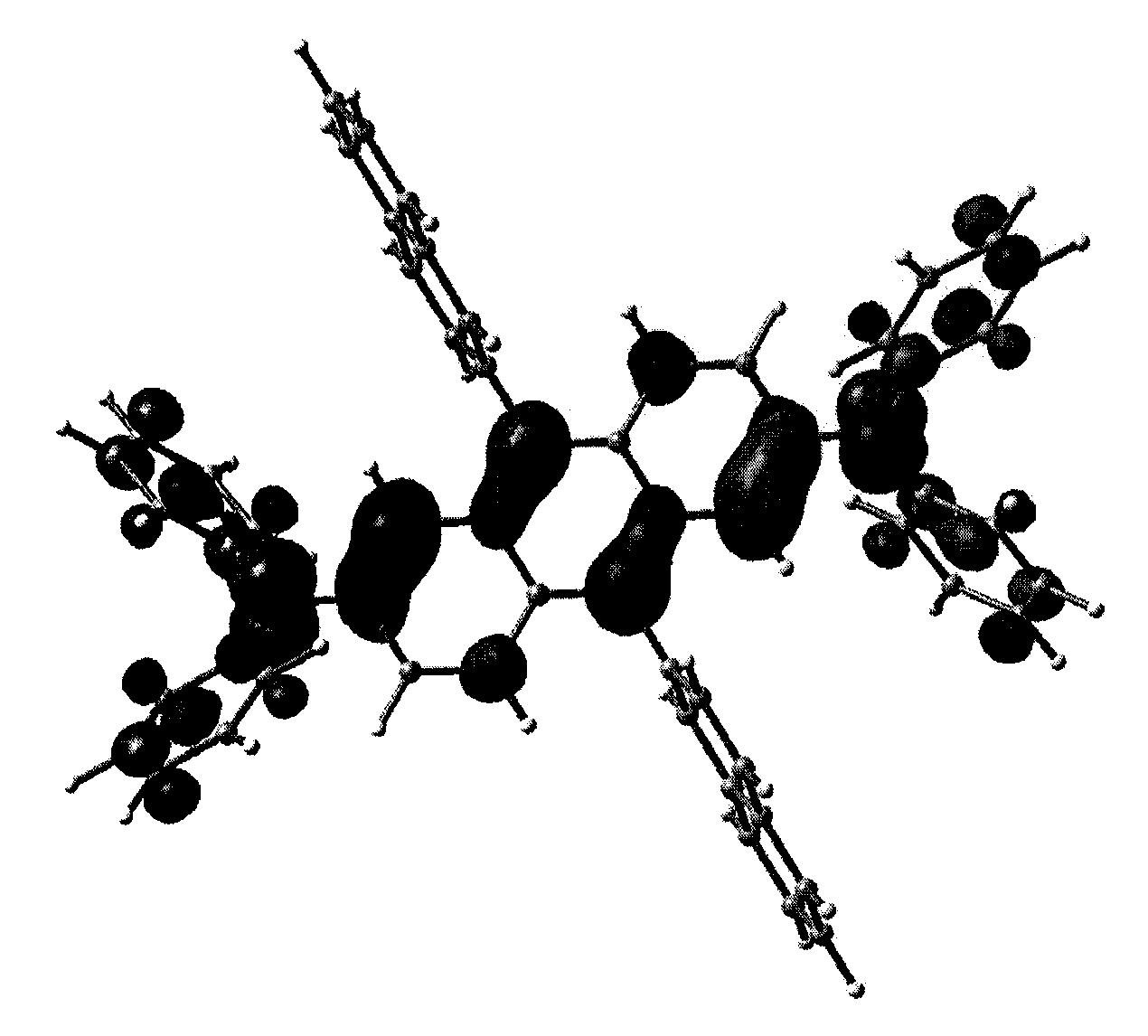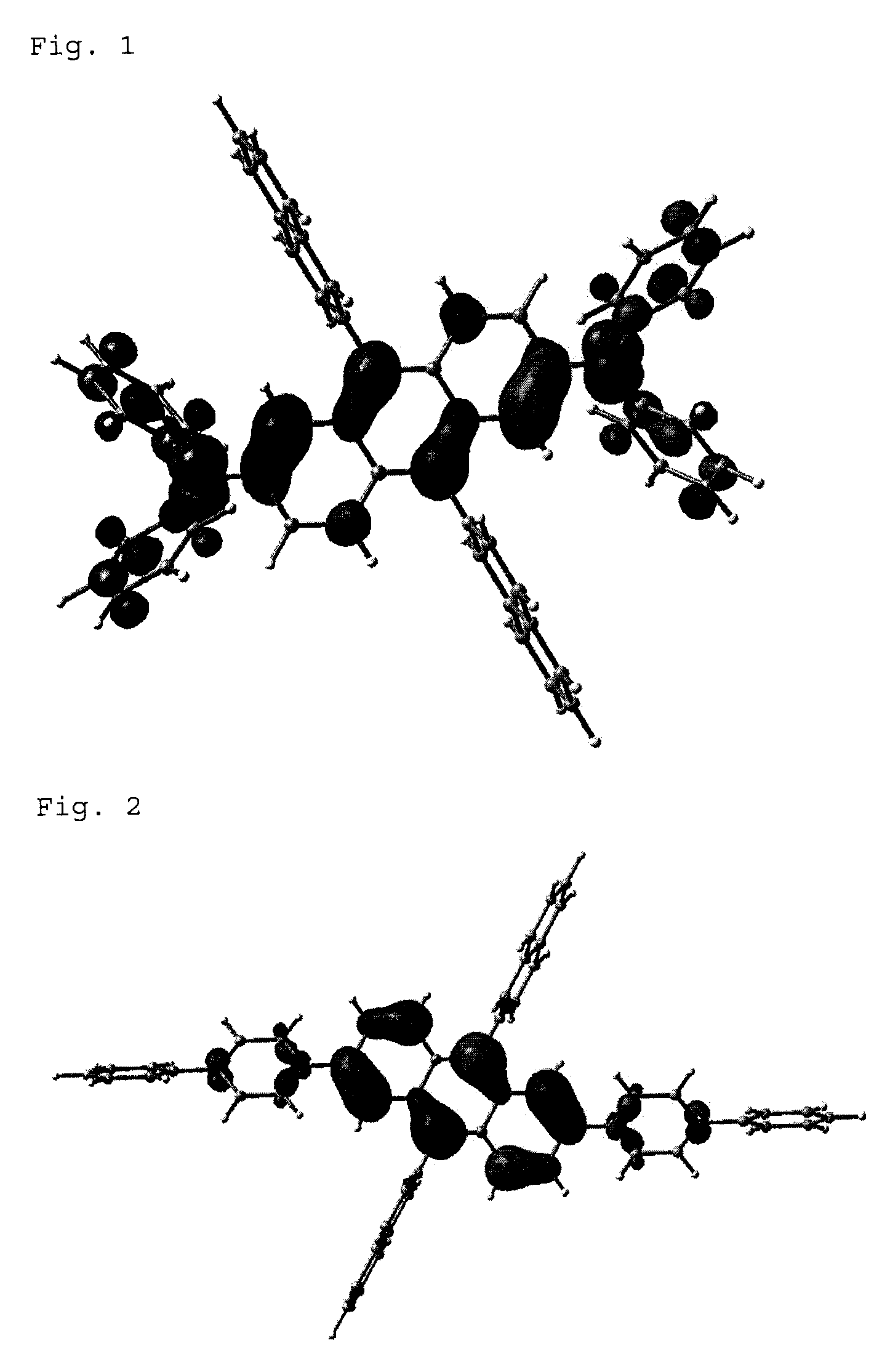Green Electroluminescent Compounds and Organic Electroluminescent Device Using the Same
a technology of green electroluminescent materials and organic electroluminescent devices, which is applied in the direction of discharge tube luminescnet screens, perylene derivatives, anthracene dyes, etc., can solve the problems of insufficient enhancement of the lifespan of green materials, insufficient green electroluminescent materials having long life, and insufficient green electroluminescent materials. achieve the effect of high efficiency, high efficiency and high efficiency
- Summary
- Abstract
- Description
- Claims
- Application Information
AI Technical Summary
Benefits of technology
Problems solved by technology
Method used
Image
Examples
preparation example 1
Preparation of Compound (1) (Chemical Formula 1: R1=R2=2-naphthayl, R3=R4=R5=R6=phenyl)
[0049]In dry toluene, dissolved were 2,6-dichloroanthraquinone (1.0 g, 3.6 mmol) and diphenylamine (1.3 g, 7.7 mmol), and palladium acetate (Pd(OAc)2)(2.4 g, 24.4 mmol), tri(t-butyl) phosphine (P(t-Bu)3) (0.2 mL, 1.9 mmol) and sodium t-butoxide (t-BuONa) (0.93 g, 9.7 mmol) were added thereto. The resultant mixture was heated under reflux at 110° C. for 3 days. When the reaction was completed, 10 mL of distilled water was added, and the mixture was stirred for 30 minutes. The solid generated was filtered, washed with solvent such as acetone and THF, dried and recrystallized from methylene chloride to give bis(2,6-diphenylamino)anthraquinone (1.1 g, 2.0 mmol, yield: 56%).
[0050]Diethyl ether solution (5 mL) of 2-naphthyllithium which had been previously prepared by using diphenylamine (0.74 g, 4.4 mmol) and n-buthyllithium (n-BuLi) (1.8 mL, 4.5 mmol, 2.5 M in hexane) was slowly added to a solution of...
preparation example 2
Preparation of Compound (2) (Chemical Formula 1: R1=R2=R3=R5=2-naphthayl, R4=R6=phenyl)
[0054]The same procedure as described in Preparation Example 1 was repeated but using N-phenyl-2-naphthylamine (1.7 g, 7.8 mmol) to obtain Compound (2) (0.53 g, 0.61 mmol, overall yield: 17%).
[0055]1H NMR (200 MHz, CDCl3): δ 6.45 (d, 4H), 6.6 (t, 2H), 6.75-6.8 (m, 8H), 7.0-7.15 (m, 6H), 7.2-7.3 (m, 6H), 7.45-7.6 (m, 10H), 7.65-7.8 (m, 6H), 7.9 (s, 2H)
[0056]MS / FAB: 864 (found), 865.10 (calculated)
preparation example 3
Preparation of Compound (3) (Chemical Formula 1: R1=R2=2-naphthyl, R3=R5=1-naphthyl, R4=R6=phenyl)
[0057]The same procedure as described in Preparation Example 1 was repeated but using N-phenyl-1-naphthylamine (1.7 g, 7.8 mmol) to obtain Compound (3) (0.41 g, 0.47 mmol, overall yield: 13%).
[0058]1H NMR (200 MHz, CDCl3): δ 6.45 (d, 4H), 6.5 (d, 2H), 6.6 (t, 2H), 6.75-6.8 (m, 4H), 7.0-7.05 (m, 4H), 7.15-7.2 (m, 4H), 7.3-7.35 (m, 8H), 7.55-7.8 (m, 14H), 7.9 (s, 2H)
[0059]MS / FAB: 864 (found), 865.10 (calculated)
PUM
| Property | Measurement | Unit |
|---|---|---|
| thickness | aaaaa | aaaaa |
| thickness | aaaaa | aaaaa |
| thickness | aaaaa | aaaaa |
Abstract
Description
Claims
Application Information
 Login to View More
Login to View More - R&D
- Intellectual Property
- Life Sciences
- Materials
- Tech Scout
- Unparalleled Data Quality
- Higher Quality Content
- 60% Fewer Hallucinations
Browse by: Latest US Patents, China's latest patents, Technical Efficacy Thesaurus, Application Domain, Technology Topic, Popular Technical Reports.
© 2025 PatSnap. All rights reserved.Legal|Privacy policy|Modern Slavery Act Transparency Statement|Sitemap|About US| Contact US: help@patsnap.com



